
The Puck Building is a historic building in the Nolita neighborhood of Manhattan in New York City. It occupies the block bounded by Lafayette, Houston, Mulberry and Jersey Streets. The building is owned by Kushner Properties.

NoHo, short for "North of Houston Street", is a primarily residential neighborhood in Lower Manhattan, New York City. It is bounded by Mercer Street to the west, the Bowery to the east, 9th Street to the north, and Houston Street to the south.
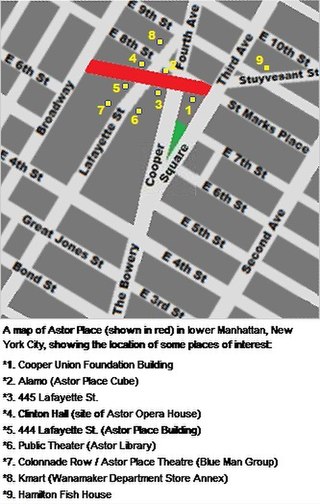
Astor Place is a one-block street in NoHo/East Village, in the lower part of the New York City borough of Manhattan. It runs from Broadway in the west to Lafayette Street. The street encompasses two plazas at the intersection with Cooper Square, Lafayette Street, Fourth Avenue, and Eighth Street – Alamo Plaza and Astor Place Station Plaza. "Astor Place" is also sometimes used for the neighborhood around the street. It was named for John Jacob Astor, soon after his death in 1848. A $21 million reconstruction to implement a redesign of Astor Place began in 2013 and was completed in 2016.

The Public Theater is an arts organization in New York City. Founded by Joseph Papp, The Public Theater was originally the Shakespeare Workshop in 1954; its mission was to support emerging playwrights and performers. Its first production was the musical Hair in 1967. Since Papp, the theatre has been led by JoAnne Akalaitis (1991–1993), and George C. Wolfe (1993–2004), and is currently under Artistic Director Oskar Eustis and Executive Director Patrick Willingham.

Astor Row is the name given to 28 row houses on the south side of West 130th Street, between Fifth and Lenox Avenues in the Harlem neighborhood of Manhattan, New York City, which were among the first speculative townhouses built in the area. Designed by Charles Buek, the houses were built between 1880 and 1883 in three spurts, on land John Jacob Astor had purchased in 1844 for $10,000. Astor's grandson, William Backhouse Astor, Jr., was the driving force behind the development.

The New York Cancer Hospital (NYCH) on the Upper West Side of Manhattan, New York City was a cancer treatment and research institution founded in 1884. The building was located at 455 Central Park West between West 105th and 106th Streets, and built between 1884 and 1886 with additions made between 1889 and 1890; it was designed by Charles Coolidge Haight in the Late Gothic and French Chateau styles – inspired by the chateaux of the Loire Valley. It was the first hospital in the United States dedicated specifically for the treatment of cancer, and the second in the world after the London Cancer Hospital. After outgrowing the original building and moving, it became what is today known as Memorial Sloan-Kettering Cancer Center.

Theodore Low De Vinne was an American printer and scholarly author on typography. Considered "the leading commercial printer of his day," De Vinne did much for the improvement of American printing and typography.

The Colony Club is a women-only private social club in New York City. Founded in 1903 by Florence Jaffray Harriman, wife of J. Borden Harriman, as the first social club established in New York City by and for women, it was modeled on similar gentlemen's clubs. Today, men are admitted as guests.
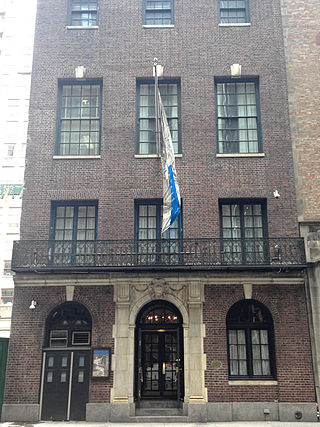
The Grolier Club is a private club and society of bibliophiles in New York City. Founded in January 1884, it is the oldest existing bibliophilic club in North America. The club is named after Jean Grolier de Servières, Viscount d'Aguisy, Treasurer General of France, whose library was famous; his motto, "Io. Grolierii et amicorum" [of or belonging to Jean Grolier and his friends], suggested his generosity in sharing books.
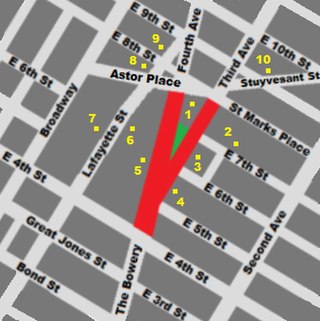
Cooper Square is a junction of streets in Lower Manhattan in New York City located at the confluence of the neighborhoods of Bowery to the south, NoHo to the west and southwest, Greenwich Village to the west and northwest, the East Village to the north and east, and the Lower East Side to the southeast.

Lafayette Street is a major north–south street in New York City's Lower Manhattan. It originates at the intersection of Reade Street and Centre Street, one block north of Chambers Street. The one-way street then successively runs through Chinatown, Little Italy, NoLIta, and NoHo and finally, between East 9th and East 10th streets, merges with Fourth Avenue. A buffered bike lane runs outside the left traffic lane. North of Spring Street, Lafayette Street is northbound (uptown)-only; south of Spring Street, Lafayette is southbound (downtown)-only.
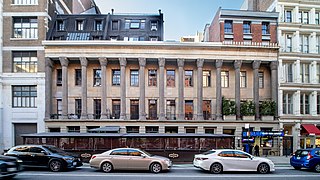
Colonnade Row, also known as LaGrange Terrace, is a group of 1830s row houses on present-day Lafayette Street in the NoHo neighborhood of Manhattan in New York City. They are believed to have been built by Seth Geer, although the project has been attributed to a number of other architects. The buildings' original name comes from the Marquis de Lafayette's estate in France, but the series of nine row houses, of which four remain, owe their existence to John Jacob Astor, who bought the property and whose grandson John Jacob Astor III later lived at No. 424. The remaining buildings are New York City designated landmarks and listed on the National Register of Historic Places under the name LaGrange Terrace. The facades remain standing on Lafayette Street south of Astor Place.

254–260 Canal Street, also known as the Bruce Building, is a building on the corner of Lafayette Street in the Chinatown neighborhood of Manhattan, New York City, United States. It was constructed in 1856–57 and designed in the Italian Renaissance revival style. The cast-iron elements of the facade may have been provided by James Bogardus, a pioneer in the use of cast iron in architecture. The building was constructed for George Bruce, a prosperous printer and inventor of new technologies in the printing industry, which was then one of New York's leading industries. It was converted to offices in 1987 by architect Jack L. Gordon.
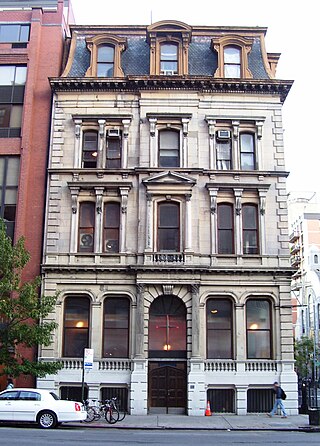
The Metropolitan Savings Bank Building opened on May 30, 1867, at the northeast corner of Third Avenue and East 7th Street, in Manhattan, New York City. Its original address was 10 Cooper Institute. The building, which was designed by architect Carl Pfeiffer in Second Empire style, is four stories high, 45 feet (14 m) wide and 75 feet (23 m) deep, and was considered at the time it opened to be one of the most finely constructed edifices, "from garret to basement." Its facades were composed of white marble, with the upper floor being enclosed by a mansard roof. The building was fireproof, as no combustible materials were used during construction, either internally or externally. The entire cost of the structure was $150,000.

Firehouse, Engine Company 31 is a historic fire station located at 87 Lafayette Street between Walker and White Streets in the Tribeca and Civic Center neighborhoods of Manhattan in New York City. It was built in 1895 and designed by architects Napoleon LeBrun & Sons, who styled it after early-16th-century chateaux in the Loire Valley of France.
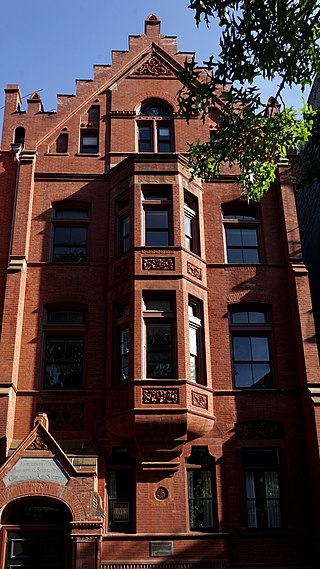
The Fourteenth Ward Industrial School is located at 256-258 Mott Street between Prince and Houston Streets in the Nolita neighborhood of Manhattan, New York City. It was built for the Children's Aid Society in 1888–89, with funds provided by John Jacob Astor III, and was designed by the firm of Vaux & Radford in the Victorian Gothic style. The Society built a number of schools for indigent children at the time. It was later known as the Astor Memorial School.
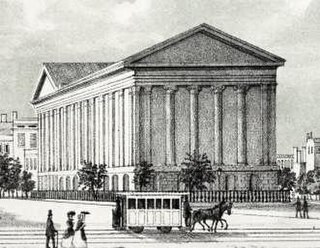
The Astor Opera House, also known as the Astor Place Opera House and later the Astor Place Theatre, was an opera house in Manhattan, New York City, located on Lafayette Street between Astor Place and East 8th Street. Designed by Isaiah Rogers, the theater was conceived by impresario Edward Fry, the brother of composer William Henry Fry, who managed the opera house during its entire history.

Alexander Saeltzer was a German-American architect active in New York City in the 1850s and 1860s. His work includes the Anshe Chesed Synagogue, Academy of Music, Theatre Francais, the Duncan, Sherman & Company building and the South Wing of the Romanesque revival structure at 425 Lafayette Street built between 1853 and 1881 as the Astor Library.

The American Bank Note Company Printing Plant is a repurposed printing plant in the Hunts Point neighborhood of the Bronx in New York City. The main structure includes three interconnected buildings. The Lafayette wing, spanning the south side of the block, is the longest and tallest, incorporating an entrance at the base of a nine-story tower. The lower, more massive Garrison wing is perpendicular. These two were built first, and constitute the bulk of the complex. Prior to the American Bank Note Company purchasing the property, the land on which the printing plant was built had been part of Edward G. Faile's estate.

William Colford Schermerhorn was an American lawyer, philanthropist, and patron of the arts.

























